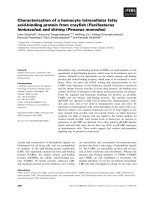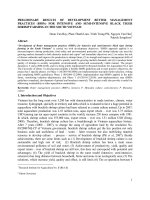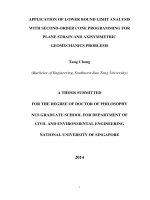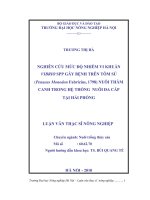Application of Bacillus spp. Isolated from the Intestine of Black Tiger Shrimp (Penaeus monodon Fabricius) from Natural Habitat for Control Pathogenic Bacteria in Aquaculture ppt
Bạn đang xem bản rút gọn của tài liệu. Xem và tải ngay bản đầy đủ của tài liệu tại đây (299.38 KB, 8 trang )
Application of Bacillus spp. Isolated from the Intestine of Black
Tiger Shrimp (Penaeus monodon Fabricius) from Natural Habitat
for Control Pathogenic Bacteria in Aquaculture
Watchariya Purivirojkul
1
* and Nontawith Areechon
2
ABSTRACT
Bacillus spp. were isolated from the intestine of black tiger shrimp Penaeus monodon which
were collected from the Gulf of Thailand at Chonburi province area during October 2005 to September
2006. The bacterial antagonist activity were tested with aquacultural pathogenic bacteria. The cross
streak method results showed that Bacillus W803 and Bacillus W120 could inhibit Aeromonas hydrophila
AQAH after 24 hours. The highest level of antibacterial substances of these Bacillus were found in 48
hours. However, Bacillus W120 could produce antibacterial substances higher than Bacillus W803.
Bacillus W806 and Bacillus W902 could colonize Streptococcus agalactiae AQST after 48 hours of
incubation. Although cross streak method did not show any effect between Bacillus spp. and Vibrio
harveyi AQVH, but Transmission Electron Microscope (TEM) observations showed the size of V. harveyi
cell at cross streaking point with Bacillus WL01 to be smaller compared to normal cell with width and
length reduction of 58.54% and 72.07%, respectively. Application of these selected Bacillus strains to
use for control the pathogenic bacteria were conducted. The amount of A. hydrophila AQAH co-cultured
in sterile tap water with Bacillus W803 and Bacillus W120 were decreased by 22.42 and 27.05%,
respectively. The amount of S. agalactiae AQST co-cultured in sterile tap water with Bacillus W806
and Bacillus W902 were decreased by 11.98 and 11.97%, respectively. The amount of V. harveyi AQVH
co-cultured in sterile artificial sea water (20 ppt) with Bacillus WL01 and Bacillus W1106 were decreased
by 22.75 and 20.23%, respectively. Moreover, Bacillus spp. could survive in water more than 5 days
and could decrease pathogenic bacteria from 10
6
to 10
5
CFU/ml in 24-48 hours. These results suggest
that these Bacillus spp. can be applied as effective probiotic to control pathogenic bacteria in aquaculture.
Key words: Bacillus, Aeromonas hydrophila, Streptococcus agalectiae, Vibrio harveyi, probiotic
Kasetsart J. (Nat. Sci.) 41 : 125 - 132 (2007)
1
Department of Zoology, Faculty of Science, Kasetsart University, Bangkok 10900, Thailand.
2
Department of Aquaculture, Faculty of Fisheries, Kasetsart University, Bangkok 10900, Thailand.
* Corresponding author, e-mail :
INTRODUCTION
Many bacterial diseases have been
reported to cause mortality in cultured shrimp and
fish both in the hatchery and grow-out ponds.
Aeromonas hydrophila, a gram negative, short,
motile, rod bacterium, causing motile aeromonads
septicemia, is the most common freshwater fish
pathogen. Streptococcus agalactiae, a gram
positive, non motile, non spore-forming coccus
that occurs in chains or in pairs of cells, is a cause
of streptococcal disease in Oreochromis niloticus.
126
Kasetsart J. (Nat. Sci.) 41(5)
Vibrio harveyi, a luminous gram negative marine
bacterium that causes luminescent bacterial
disease, is a serious disease problem in shrimp
aquaculture. Disease outbreaks are recognized as
important constraints to aquaculture production
and trade and
since the development of antibiotic
resistance has become a matter
of growing
concern. One of the alternatives to antimicrobials
in disease control could be the use of probiotic
bacteria as microbial
control agents (Verschuere
et al., 2000).
Probiotics such as the gram positive
Bacillus offers an alternative to antibiotic therapy
for sustainable aquaculture. Although many genera
of bacteria were used as probiotic in aquaculture
such as Vibrio alginolyticus, Pseudomonas
fluorescens and Alteromonas sp. (Douillet and
Langdon, 1994; Austin et al., 1995; Gram et al.,
2001), Bacillus species offer several advantages
over gram negative bacteria, including longer shelf
life, because they produce endospores that are
tolerant to heat and desiccation, and the broad
spectrum activities of their secondary metabolites
(Kim et al., 2001; Jock et al., 2002). In vitro
production of inhibitory compounds toward
known pathogens for the considered species has
often been used in the selection of putative
probiotics (Verschuere et al., 2000).
In this study, the potential probionts
which were isolated from intestine of wild Penaeus
monodon were tested by focusing on competitive
and inhibitive capabilities against some common
pathogenic bacteria in aquaculture including
V. harveyi, A. hydrophila and S. agalactiae.
MATERIALS AND METHODS
Isolation and identification of Bacillus spp.
Bacillus spp. were isolated from the
intestine of Penaeus monodon collected from the
Gulf of Thailand at Chonburi province. Every
month, during October 2005 to September 2006,
10 samples of shrimp (weight > 80 g) were
investigated. Intestines were ground by
homogenizer and were dissolved in 5 ml of 1.5%
NaCl per animal and the diluted 1.5% NaCl were
heat shocked on water bath at 80 °C for 20 min
followed by cold shock with normal tap water
immediately. Then the intestine solution was
spreaded on plates using spread plate technique
on Nutrient agar (NA) supplemented with 1.5%
NaCl (w/v) and incubated at 30
°C for 24 hours.
Isolates were purified by streaking on NA
supplemented with 1.5% NaCl (w/v). Catalase test
were used for identifying Bacillus species. Each
of the strain was examined with the basic
biochemical tests API 20E (bioMârieux). API
CHB Medium and API 50 CH strips were used to
study the metabolites of 49 different carbon
sources. The API strips were incubated at 37°C.
The results were read after 24 and 48 hours and
analysed with the APILAB Plus software.
Pathogenic bacteria
V. harveyi AQVH was isolated from
diseased P. monodon, A. hydrophila AQAH was
isolated from diseased hybrid catfish and S.
agalactiae AQST was isolated from diseased
Oreochromis niloticus obtained from Aquatic
Animal Health Management Laboratory,
Department of Aquaculture, Faculty of Fisheries,
Kasetsart University.
Colonization and inhibition activities of Bacillus
spp. on the pathogenic bacteria
Bacillus spp., A. hydrophila AQAH and
S. agalactiae AQST were cultured on nutrient agar
and incubated at 30°C for 24 hours V. harveyi
AQVH was cultured on NA supplemented with
1.5% NaCl (w/v). Colonization activities tests
were done on NA (A. hydrophila AQAH and S.
agalactiae AQST) and NA supplemented with
1.5% NaCl (w/v) (V. harveyi AQVH) by cross
streak method (Lemos et al., 1985). Pathogenic
bacteria was streaked in the first line and then
Bacillus spp. was streaked perpendicular to it. Each
Kasetsart J. (Nat. Sci.) 41(5)
127
type of bacterium streaking was done in triplicate
and they were incubated at 30°C for 96 hours.
Inhibition activities and colonization effect were
observed at 24, 48, 72 and 96 hours.
Inhibition activities of selected Bacillus spp.
This method was modified from Jock et
al. (2002). Bacillus from single colony was
transferred to NA plate as three spots per plate and
grown for 1 day, 2 days and 3 days at 30°C. A.
hydrophila AQAH was grown overnight in NB
broth and 0.2 ml of the culture of A. hydrophila
AQAH in NB was mixed with 20 ml NA agar (40-
45°C). This suspension was gently poured on top
of the agar with the pregrown Bacillus isolates.
After incubation for 24-48 hours at 30°C, the plates
were inspected for growth inhibition zones on the
lawn of A. hydrophila AQAH. The comparison
between size of clear zone in the Bacillus spp. plate
which were inoculated 1 day, 2 days and 3 days
were determined.
Morphological change of V. harveyi AQVH after
colonization
V. harveyi was isolated from the coloni-
zation area, especially from the cross streaking
point as well as from the control. All samples were
cultured on TCBS agar and incubated at 30°C for
24 hours. Single colony was used to determine
morphological deviation by TEM.
Co-culture of Bacillus spp. with pathogenic
bacteria in sterile tap water and artificial sea
water
Bacillus spp. was tested for antagonistic
activity against pathogenic bacteria in a co-culture
experiment. Bacillus and pathogenic bacteria were
separately pre-cultured in 10 ml NB (Nutrient
Broth) for 24 hours (110 rpm). Sterile tap water
were inoculated with 10
5
CFU/ml pathogenic
bacteria together with 10
5
CFU/ml of Bacillus spp.
Bacillus W120 and Bacillus W803 were tested
with A. hydrophila AQAH in sterile tap water.
Bacillus W806 and Bacillus W902 were tested
with S. agalactiae AQST in sterile tap water.
Bacillus W1106 and Bacillus WL01 were tested
with V. harveyi AQVH in artificial sea water (20
ppt). Each Bacillus and pathogenic bacteria had
control group (monoculture) for compare the
bacterial concentration. Flasks were incubated at
room temperature. All combinations were tested
in triplicate. Samples were collected after 0, 12,
24, 48, 72, 96 and 120 hours for enumeration of
the number of bacteria.
RESULTS
Isolation and identification of Bacillus spp.
From 120 samples of P. monodon, 114
strains of genus Bacillus were isolated for
antagonistic studies.
Colonization and inhibition activities of Bacillus
spp. on the pathogenic bacteria
After incubated for 48 hours, Bacillus
W120 and Bacillus W803 showed inhibition effect
against A. hydrophila AQAH. On the test plate,
some clear zone areas were existed and more
colonization areas were observed after 72 hours
(Figure 1.1). Bacillus W806 and Bacillus W902
showed colonization effect against S. agalactiae
AQST (Figure 1.2). However, there were no effect
between Bacillus spp. and V. harveyi AQVH
(Figure 1.3).
Inhibition activities of selected Bacillus spp.
Bacillus W120 and Bacillus W803 which
showed inhibition effect to A. hydrophila AQAH
from previous experiment were selected. The
results showed that Bacillus W120 could produce
antibacterial substance higher than Bacillus W803
and these Bacillus spp. could produce antibacterial
substances in highest level in 2 days (Figure 2)
but thery were not significantly different at p=0.05
from 3 days as measured by size of clear zone
(Table 1).
128
Kasetsart J. (Nat. Sci.) 41(5)
Figure 1 Inhibition and colonization activities of Bacillus spp. on pathogenic bacteria in vitro at 96
hours.
1.1 inhibition effect of Bacillus W120 against Aeromonas hydrophila AQAH
1.2 colonization activities of Bacillus W902 against Streptococcus agalectiae AQST
1.3 no effect between Bacillus W1106 and Vibrio harveyi AQVH
Table 1 Size of clear zone of Bacillus W120 and Bacillus W803 when pre-cultured Bacillus spp. 1,
2 and 3 days showing inhibition effect against Aeromonas hydrophila.
Size of clear zone (mm)
1 day 2 days 3 days
Bacillus W120 26.67
+ 1.15
b
37.67 + 0.58
a
37.33 + 0.58
a
Bacillus W803 17.00 + 1.00
b
32.00 + 2.00
a
32.67 + 1.15
a
Means values within the same row sharing the same superscript are not significantly different at P = 0.05
Figure 2 Inhibition zone of Bacillus W120 and Bacillus W803 against Aeromonas hydrophila after
incubated Bacillus 1 day (A) and after incubated Bacillus 2 days (B).
Morphological change of V. harveyi AQVH after
colonization
The cross streaking point between V.
harveyi and each Bacillus spp. on the TCBS agar
was isolated for V. harveyi. The size of normal V.
harveyi and those colonized by Bacillus WC01,
Bacillus WBL01, Bacillus W1106 and Bacillus
WL01 were about 0.82 × 1.79 µm, 0.80 × 1.34
µm, 0.67 × 1.21 µm, 0.42 × 0.59 µm and 0.34 ×
0.50 µm, respectively as shown in Figure 3. The
results indicated that V. harveyi colonized by
Bacillus WL01 showed significant morphological
changes.
Kasetsart J. (Nat. Sci.) 41(5)
129
Co-culture of Bacillus spp. with pathogenic
bacteria in sterile tap water and artificial sea
water
The presence of Bacillus W120 and
Bacillus W803 inhibited growth of A. hydrophila
AQAH during 48 hours from 4.40 × 10
6
CFU/ml
of control to 9.85 × 10
5
and 1.99 × 10
6
CFU/ml,
respectively. A further reduction was seen over the
following 120 hours, reducing A. hydrophila
AQAH from 2.77 × 10
5
CFU/ml to 9.37 × 10
3
and
1.67 × 10
4
CFU/ml which counted for 27.05 and
22.42% reduction.
The presence of Bacillus W902 and
Bacillus W806 inhibited growth of S. agalectiae
AQST during 72 hours from 3.73 × 10
6
CFU/ml
of control to 7.97 × 10
5
and 2.13 × 10
6
CFU/ml,
respectively. A further reduction was seen over the
following 120 hours, reducing S. agalectiae AQST
from 1.13 × 10
6
CFU/ml to 2.14 × 10
5
and 2.13 ×
10
5
CFU/ml which counted for 11.97 and 11.98%
reduction.
The presence of Bacillus WL01 and
Bacillus W1106 inhibited growth of V. harveyi
AQVH during 48 hours from 4.70 × 10
6
CFU/ml
of control to 2.87 × 10
6
and 2.93 × 10
6
CFU/ml,
respectively. A further reduction was seen over the
following 120 hours, reducing V. harveyi AQVH
from 4.10 × 10
5
CFU/ml to 2.17 × 10
4
and 3.00 ×
10
4
CFU/ml which counted for 22.75 and 20.23%
reduction. While Bacillus spp. concentrations in
co-culture treatment did not differ (P>0.05) from
control treatment (Figure 4).
DISCUSSION
Many researchers are trying to use
probiotic bacteria in aquaculture to improve water
quality by balancing bacterial population in water
and reducing pathogenic bacterial load. Sources
of probiotic bacteria may come from animals such
Figure 3 Morphological structure of normal Vibrio harveyi and Bacillus WL01 compared with those
deviated from colonization by TEM.
130
Kasetsart J. (Nat. Sci.) 41(5)
Figure 4 Growth of Bacillus spp. and pathogenic bacteria monoculture and co-culture in sterile tap
water and artificial sea water.
A. Bacillus W120 B. Bacillus W803 and A. hydrophila AQAH C. Bacillus W806
D. Bacillus W902 and S. agalectiae AQST E. Bacillus W1106
F. Bacillus WL01 and V. harveyi AQVH
as from intestine (Sugita and Shibuga, 1996) or
environments (Nogami and Maeda, 1992). In this
study, we focused only genus Bacillus sp. which
showed antagonistic activity to pathogenic bacteria
in aquaculture in many studies (Devaraja et al.,
2002; Vaseeharan and Ramasamy, 2003). Bacillus
spp. are commonly found in marine sediments and
therefore are naturally ingested by animals such
as shrimps that feed in or on the sediments
(Moriarty, 1998). So, we isolated Bacillus spp.
from intestine of P. monodon captured from natural
habitat and tested for antagonistic activity to
pathogenic bacteria in aquaculture.
Bacillus W120 and Bacillus W803
Kasetsart J. (Nat. Sci.) 41(5)
131
showed inhibition effect to A. hydrophila AQAH.
The antibacterial substance was produced in
highest level in 48 hours. This result could explain
the reduction of A. hydrophila AQAH in co-culture
experiment with Bacillus W120 and Bacillus
W803. In 48 hours, A. hydrophila AQAH in co-
culture was reduced from 10
6
to 10
5
CFU/ml might
be caused by high level of antibacterial substance.
By using the cross-streaking method, Bacillus
W806 and Bacillus W902 were observed to
colonize S. agalactiae AQST. But in co-culture
experiment, Bacillus W806 and Bacillus W902
could decrease only 11.97-11.98% of S. agalactiae
AQST.
Although Bacillus WL01 and Bacillus
W1106 did not show colonization effect but they
showed some inhibition effect to V. harveyi
AQVH, which confirmed by distorted shape of V.
harveyi AQVH by TEM. The shape of V. harveyi
AQVH had smaller size and some area of cell wall
was destroyed. In this case, Bacillus spp. might
produce some metabolites, for instance, antibiotic
(Williams and Vickers, 1986) or enzymes for
inhibition and/or digestion (Bruno and Montville,
1993). However, in co-culture experiment,
pathogenic bacteria were used in high level. In
general, the number of luminous bacteria in coastal
area ranged from 0.7×10
1
to 7.3×10
1
CFU/ml
(Sudthongkong, 1996). In freshwater, total bacteria
varied from 3.1×10
2
to 1.0×10
3
CFU/ml (de Sousa
and Silva-Souza, 2001). In fish pond water, total
bacteria ranged from 1.8 ± 0.9×10
2
to 6.0 ± 1.2×10
4
CFU/ml (Al-Harbi, 2003). So, due to the high
amount of pathogenic bacteria used with study,
the inhibition effect in co-culture experiment might
not be that significant.
Many studies supported that Bacillus sp.
could reduce pathogenic bacteria in aquaculture.
Vaseeharan and Ramasamy (2003) reported
P. monodon immersed in Bacillus subtilis BT23
at a density of 10
6
-10
8
CFU/ml for 6 days showed
90% reduction in accumulated mortality when
challenge with V. harveyi at 10
3
- 10
4
CFU/ml for
1 hour. Devaraja et al. (2002) used microbial
products, Bacillus sp., Saccharomyces sp.,
Nitrosomonas sp. and Nitrobacter sp. in fish and
shrimp pond by immersion for 110 days, the results
showed that Bacillus spp. were dominant in all
ponds and the bacterial populations were changed
by use this probiotic. In our studies, Bacillus sp.
in monoculture and co-culture did not decrease
during the experiment.
In summary, it has been demonstrated
that Bacillus W120, Bacillus W803 produced
substances that could inhibit the growth of the
pathogenic bacteria; Bacillus W806, Bacillus
W902, Bacillus WL01 and Bacillus W1106
showed competitively exclude the pathogenic
bacteria. So, the presence of these Bacillus spp.
could protect the aquatic animals against the
infection by pathogenic bacteria and might be
applied as good probiotic in aquaculture.
ACKNOWLEDGEMENTS
This research was supported by Kasetsart
University Research and Development Institute
(KURDI). We thank Ms. Patcharee Umrung,
Central lab KU for TEM.
LITERATURE CITED
Al-Harbi, A.H. 2003. Faecal coliforms in pond
water, sediments and hybrid tilapia
Oreochromis niloticus×Oreochromis aureus
in Saudi Arabia. Aquac. Res. 34(7): 517.
Austin, B., L.F. Stuckey, P.A.W. Robertson,
I. Effendi and D.R.W. Griffith. 1995.
A probiotic strain of Vibrio alginolyticus
effective in reducing diseases caused by
Aeromonas salmonicida, Vibrio anguillarum
and Vibrio ordalii. J. Fish Dis. 18: 93-96.
Bruno, M.E.C. and T.J. Montville. 1993.
Common mechanistic action of bacteriocins
from lactic acid bacteria. Appl. Environ.
Microbiol. 59: 3003– 3010.
132
Kasetsart J. (Nat. Sci.) 41(5)
de Sousa, J.A. and A.T. Silva-Souza. 2001.
Bacterial community associated with fish and
water from Congonhas River, Sertaneja,
Paraná, Brazil. Braz. Arch. Biol. Technol.
44: 4.
Devaraja, T.N., F.M. Yusoff and M. Shariff. 2002.
Changes in bacterial populations and shrimp
production in ponds treated with commercial
microbial products. Aquaculture 206: 245-
256.
Douillet, P.A. and C.J. Langdon. 1994. Use of
probiotic for the culture of larvae of the pacific
oyster (Crassostrea gigas Thunberg).
Aquaculture 119: 25-40.
Gram, L., T. Lovod, J. Nielsen, J. Melchiorsen and
B. Spanggaard. 2001. In vitro antagonism of
the probiont Pseudomonas fluorescens AH2
against Aeromonas salmonicida does not
confer protection of salmon against
furunculosis. Aquaculture 199: 1-11.
Jock, S., B. Völksch, L. Mansvelt and K. Geider.
2002. Characterization of Bacillus strains
from apple and pear trees in South Africa
antagonistic to Erwinia amylovora. FEMS
Microbiol. Lett. 211: 247-252.
Kim, W.S., M. Hildebrand, S. Jock and K. Geider.
2001. Molecular comparison of pathogenic
bacteria from pear trees in Japan and the fire
blight pathogen Erwinia amylovora.
Microbiology 147: 2951-2959.
Lemos, M.L., A.E. Toranzo and J.L. Barja. 1985.
Antibiotic activity of epiphytic bacteria
isolated from intertidal seaweeds. Microb.
Ecol. 11: 149-163.
Moriarty, D.J.W. 1998. Control of luminous
Vibrio species in penaeid aquaculture ponds.
Aquaculture 164: 351-358.
Nogami, K. and M. Maeda. 1992. Bacteria as
biocontrol agents for rearing larvae of the crab
Portunus trituber Culatus. Can. J. Fish.
Aquat. Sci. 49: 2373-2376.
Sudthongkong, C. 1996. Identification and drug
resistance of luminous bacteria in coastal area
of Inner Gulf of Thailand. The AAHRI
Newsletter 5: 2.
Sugita H. and K. Shibuga. 1996. Antibacterial
abilities of intestinal bacteria in freshwater
cultured fish. Aquaculture 145: 195-203.
Vaseeharan, B. and P. Ramasamy. 2003. Control
of pathogenic Vibrio spp. by Bacillus subtilis
BT23, a possible probiotic treatment for black
tiger shrimp Penaeus monodon. Lett. Appl.
Microbiol. 36(2): 83.
Verschuere, L., G. Rombaut, P. Sorgeloos and W.
Verstraete. 2000. Probiotic bacteria as
biological control agents in aquaculture.
Microbiol. Mol. Biol. R. 64: 655-669.
Williams, S.T. and J.C. Vickers. 1986. The
ecology of antibiotic production. Microb.
Ecol. 12: 43–52.









